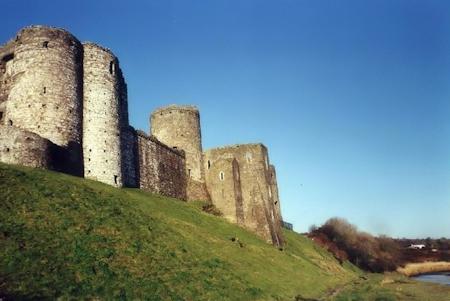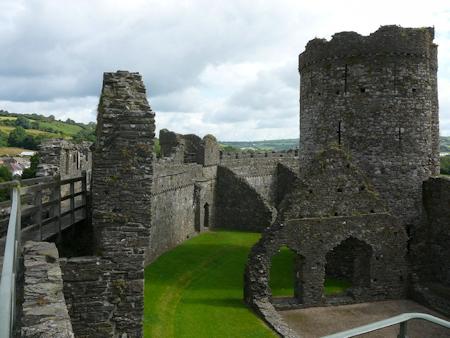
Kidwelly Castle
First constructed in 1114, Kidwelly Castle is a concentric Norman castle. It was built on a ridge overlooking the River Gwendraeth. Though originally built in timber it later came into royal possession and was strengthened against a possible French invasion.
Kidwelly Castle Early History
The first castle at Kidwelly was built by Roger de Caen, bishop of Salisbury. He was a rich, powerful man who had already constructed a number of stone castles in England.
Kidwelly was a frontier effort however. It was constructed in wood in a half-ringwork shape and used the river and its steep bank to protect the eastern flank. Roger also founded a priory on the other side of the river.
In 1136 shortly after the death of King Henry I of England saw an opportunity to regain their land in the chaos. Gruffydd ap Rhys, the ruler of Deheubarth raised an army and attacked the English. They were defeated and Gruffydd went north to get reinforcements.
His wife Maes Gwenllian raised an army in his absence and attacked Kidwelly. Her army was met by the forces of Maurice de Londres about a mile from the town. She was defeated and, so the story goes, decapitated. She is celebrated as a local hero and a memorial to her stands just outside Kidwelly Castle's gatehouse.
The early castle changed hands a number of times. After Roger's death in 1137 it came into the possession of Maurice de Londres, Lord of Kidwelly. In 1190 The Lord Rhys, Rhys ap Gruffydd, a powerful Welsh prince conquered the castle, but it was back in Norman hands shortly after 1200. His son captured Kidwelly again and burned the castle.
By the time of the Welsh uprising in 1257 it was in the hands of Patrick de Chaworth via marriage. The settlement at Kidwelly was partly destroyed, but the castle wasn't taken.
The Stone Castle
The stone castle was probably started in the early 1270s when Payn de Chaworth came of age. The inner ward was completed in the first phase of construction along with the great hall and solar. Payn died in 1277 and it's likely that he didn't see the inner ward completed.
Payn's daughter Matilda married Henry, 3rd Earl of Lancaster, in 1298. Henry brought money and English influence to the continuing construction of Kidwelly.
Henry constructed the outer curtain and the strong keep-gatehouse. He also extended the castle walls around the town and rebuilt the priory church across the river.
In 1403 Owain Glyndwr's forces besieged Kidwelly and burnt the town. He didn't get into the castle though as it was relieved by English forces three weeks later.
Kidwelly passed down with the estates of the duchy of Lancaster. Eventually it belonged to the Crown. Henry IV and Henry V both spent money here. The river estuaries of Wales were vulnerable to a French landing at the time and they wanted to have strong defences in place.
By 1422 the gatehouse was finally complete.
Kidwelly Castle Layout
The layout of the walls at Kidwelly is unusual. The eastern flank has a naturally strong defence in the form of the river and its steep bank. On the other sides the outer curtain still follows the shape of the old ringwork and has a, now dry, moat surrounding it.
The gatehouse on the southern side is massive and defended by a drawbridge. Inside the gate passage there are doorways leading to store rooms and the porter's lodge. At ends of the passage attackers would have had to contend with wooden gates, a portcullis and machicolations.
Once through the gate you can see the inner curtain. It is more or less square in shape and the great hall and solar are found inside its inner bailey.
Kidwelly Castle doesn't really have a keep as such. The South-West tower of the inner bailey is probably the closest thing it has. It's not really bigger than other towers though it does have extra protection against fire.
The other tower of note is the Chapel Tower. It was constructed by Henry of Lancaster and features a chapel with a fine arched roof. Its turret contains a sacristy and a bedroom for the priest.
In the late 15th Century Kidwelly Castle was granted to Sir Rhys ap Thomas. It formed part of a range of lands and lucrative offices he was awarded in South Wales for his loyalty and service to King Henry VII.
Sir Rhys ap Thomas added some domestic buildings to the castle including a new hall and the North Gate.
After his death Kidwelly gradually fell into decline. It was garrisoned during the English Civil War, but there is no record of any military action here.
Today Kidwelly Castle is a property of Cadw and surprisingly well preserved. Visitors are welcomed and facilities available include a gift shop; toilets, including disabled facilities; cycle stands and car parking.
Kidwelly Castle was has also been used as a filming location. It was used for the far off castle shots in Monty Python and the Holy Grail.
Status: Visitor Attraction / Historic Monument
Owner: Cadw
Tel: +44 (0)1554 890 104
Website: cadw.wales.gov.uk
Opening Times: Open Daily March to June 9.30am-5pm / July and August 9.30am-6pm / September and October 9.30am-5pm / November to February Mon-Sat 10am-4pm Sun 11am-4pm


Kidwelly Castle and River Gwendraeth

Battlements at Kidwelly Castle